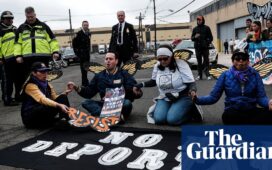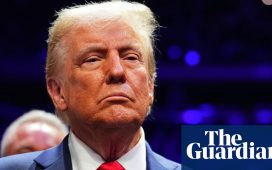The Republican party has made it clear it doesn’t like pronouns. But two in particular have become the seething core of the worldview it holds: “they” and “them”.
Just hours after the former president was shot at on 13 July, Cory Mills, a Republican US representative from Florida, posted on X: “First they tried to silence him. Then they tried to imprison him. Now they try to kill him.”
Mills didn’t need to explain what he meant by “they”, because for his fellow Republicans, it was obvious. Never mind that the actual shooter was soon thereafter revealed to be a 20-year-old white, native-born American male and a registered Republican. Regardless of who pulled the trigger, the actual enemy was always going to be “they” and “them” – the woke, the left, the mainstream media, the consortium of vengeful losers and thwarted despoilers of the American way of life that Trump, in all of his muscular patriotism, claimed to stand defiantly against.
Republicans abhor “they” and “them” not just in their gender usage (though they have expended plenty of rage at how the terms have been embraced by those whose identity doesn’t sit at either of the binary endcaps). For the right, the terms have become something more, enigmatic signifiers of lurking dread, of implacable alienness, of a vast and increasingly visible enemy both within and just beyond America’s borders.
And despite his promises to use his nomination as an opportunity to foster civic healing and national harmony, Donald Trump went even further in weaponizing the pronouns at the Republican national convention, giving them an explicitly racist and xenophobic spin as he held forth about how America’s “immigration crisis” was spreading “misery, crime, poverty, disease and destruction to communities all across our land” and decried the way that our nation’s cities were being “flooded” by the “greatest invasion in history” of murderous maniacs from “every corner of the earth, not just from South America, but from Africa, Asia, [and the] Middle East”.
Was it a coincidence that the “them” of these regions are all predominantly brown in complexion? Unlikely, given how Trump has defined his racial hierarchy in the past, placing Europe, particularly Nordic Europe, at the top, Asia in the middle, and the nations of Africa, the Caribbean and Latin America at the bottom of the pyramid as, reportedly, “shithole countries”.
Trump’s white-supremacist eruption wasn’t spontaneous, nor were these views limited to the GOP’s once and current standard bearer. That they were planned and purposeful, that they represent the party’s promises and policy, could not have been made clearer than when cameras panned across the convention floor, revealing a frothing sea of jubilant delegates – the vast majority of them white – holding up shiny blue pre-printed signs bearing the slogan “MASS DEPORTATION NOW!”
The message being sent: huddled masses, yearning to breathe free? Not here. We have no air to share. No bread to spare. No place at the table. No room at the inn. This land is our land. Not theirs. They don’t belong here. Kick them out.
To me as an Asian American member of a group whose appearances, names and heritage have historically marked us as one of “them”, the message landed like the swing of a bat.
We trace our personal or ancestral origins to the so-called Asiatic barred zone – the majority of an entire continent spanning the Middle East, India and south-east Asia whose multitudes were banned by law from migrating to this nation. We remember that Japanese Americans were rousted out of their homes and herded into camps by executive order, that US soldiers were sent to bomb cities and burn villages in Korea and Vietnam, that Indians and other south Asians were beaten and murdered in the wake of the terror attacks of 9/11, that just a few years ago, people of Chinese descent – or even of remotely similar appearance – were being subjected to social vilification and brutal attack due to a campaign led by this very former president to put a foreign face on the global pandemic.
We remember this history; we don’t want to repeat it. That’s part of why, for several generations now, Asian Americans have aligned overwhelmingly with Democrats, with two-thirds of that population pulling levers for blue, more than any group other than Black Americans (Tom Bonier, CEO of the Democratic political data analysis firm TargetSmart, believes unexpectedly high Asian American turnout represented the entire margin of Joe Biden’s slim victory in 2020). Yet over the past four years, dragged down by economic anxiety, yearning for law and order and the successful rightwing efforts to demonize affirmative action, Asian American support for Democrats has waned, falling eight percentage points, according to a recent survey.
The toxic message of the Republican convention – focused not on immigrants as a fuel for American greatness, but as a “poison” in our nation’s blood – and the surprise elevation of the presumptive Democratic presidential nominee, Kamala Harris, the first person of Asian descent and only the second Black American and second woman to head a major party ticket, is likely to swing that pendulum back. Inspired by a historically large Black Women for Harris Zoom call that drew 44,000 attendees and raised $1.5m, the likes of the actor Mindy Kaling and the US representative Pramila Jayapal organized an impromptu 24 July Zoom rally on Harris’s behalf, bringing together more than 10,000 south Asian American women and raising more than $285,000. Countless other Asian American, queer and immigrant groups are organizing their own calls to pledge support as well. It only makes sense. After all, for Asian Americans and anyone else whose color, faith or ancestry puts us at risk of being the target of the RNC’s “MASS DEPORTATION NOW!” placards, the choice between the two parties has never been simpler, and it comes down to this:
Do you want to be part of them? Or do you want to be a part of us?








